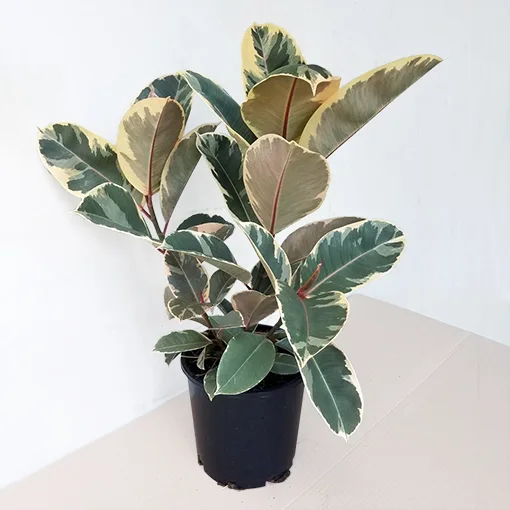Selling size: Single plant | Pot Included
The Ficus elastica Tineke, commonly known as the Rubber Plant White Variegated or just “Tineke,” is a popular houseplant known for its striking leaves with shades of green, white, and often pink or ruby red.

Here’s a comprehensive guide to Ficus Elastica Tineke, Rubber Plant White Variegated’s care:
1. Light:
- Bright, Indirect Light is Key: This is crucial for maintaining its vibrant variegation. Place it near a window that receives bright, indirect sunlight throughout the day.
- Morning Sun is Okay: Some direct morning sun can be beneficial, but protect it from harsh afternoon sun, which can scorch the delicate variegated leaves.
- Signs of Too Much Light: Fading or yellowing leaves, brown or crispy edges, or blistered spots indicate too much direct sun.
- Signs of Too Little Light: New leaves with faded colors, slow growth, leggy appearance, and overall dullness suggest it needs more light.
- Rotation: Rotate the pot by a quarter turn once a month to ensure even growth and light exposure on all sides.
2. Watering:
- Allow Soil to Partially Dry: Water thoroughly when the top 1-2 inches of soil feel dry to the touch. This typically means once every 1-2 weeks during the growing season (spring and summer) and less frequently in winter.
- Avoid Overwatering: Rubber plants are susceptible to root rot if they sit in soggy soil. Ensure the pot has drainage holes and that excess water drains out. Do not let the plant sit in standing water.
- Avoid Underwatering: While they tolerate some neglect, allowing the soil to dry out completely for extended periods can lead to leaf loss.
- Water Quality: If using tap water, let it sit overnight to allow chlorine and other chemicals to dissipate and to bring it to room temperature.
3. Soil:
- Well-Draining Mix: ‘Tineke’ thrives in a well-draining potting mix. A good quality indoor potting soil amended with perlite, sand, or pine bark for aeration and drainage is ideal.
- pH: They tolerate a range of soil pH (acid, alkaline, neutral).
4. Temperature:
- Consistent Warmth: Maintain indoor temperatures between 18°C to 24°C (65°F to 75°F).
- Avoid Drafts: Protect it from cold drafts from windows, doors, or air conditioning/heating vents, as sudden temperature changes can cause leaf drop.
5. Humidity:
- Moderate to High Humidity: As tropical plants, ‘Tineke’ appreciates higher humidity levels, although they can adapt to average indoor humidity.
- Increase Humidity: If your home is dry, especially in winter, consider:
- Misting the leaves regularly (daily or every few days).
- Placing the pot on a pebble tray filled with water (ensure the pot is not sitting in the water).
- Using a humidifier nearby.
6. Fertilizing:
- During Growing Season: Feed your ‘Tineke’ with a balanced liquid fertilizer diluted to half strength once a month during the active growing season (spring and summer).
- Reduce in Winter: Reduce or stop fertilizing in fall and winter when growth slows down.
- Avoid Over-Fertilizing: Too much fertilizer can burn the roots.
7. Pruning:
- Maintain Shape and Size: Pruning can be done for aesthetic reasons, to encourage bushier growth, or to remove old/damaged leaves.
- Timing: The best time to prune is during the spring or early summer.
- Technique: Use sharp, sterilized pruning shears. Cut just above a node (where a leaf attaches to the stem) to encourage new branching.
- Sap Caution: The milky white sap of Ficus plants can be irritating to skin and toxic if ingested. Wear gloves when pruning.
8. Repotting:
- When Root-Bound: Repot every 1-2 years or when the plant becomes root-bound (roots are circling the pot or growing out of drainage holes).
- Timing: Spring is the best time for repotting.
- Pot Size: Choose a pot that is only one size larger (e.g., 2 inches wider in diameter) than the current one.
- Fresh Soil: Use fresh, well-draining potting mix when repotting.
9. Cleaning Leaves:
- Dust Regularly: Wipe the leaves occasionally with a damp, soft cloth to remove dust. This allows the plant to photosynthesize more efficiently and keeps the leaves looking shiny.
10. Pests and Diseases:
- Common Pests: Watch out for common houseplant pests like spider mites, mealybugs, and scale insects. Inspect your plant regularly, especially the undersides of leaves.
- Treatment: Treat infestations promptly with insecticidal soap or neem oil.
- Leaf Drop: Sudden leaf drop can indicate environmental stress, such as overwatering, underwatering, cold drafts, or significant changes in light.
- Root Rot: Yellowing leaves and a general decline in health can be signs of root rot due to overwatering. If suspected, gently remove the plant from its pot and inspect the roots. Trim off any black, mushy roots and repot in fresh, well-draining soil.
11. Toxicity:
- Toxic to Pets: Ficus elastica ‘Tineke’ is considered toxic if ingested by humans, cats, and dogs, so keep it out of reach of curious pets and children. The sap can cause skin irritation.
By following these care tips, your Ficus Elastica Tineke, Rubber Plant White Variegated should thrive and continue to display its beautiful variegated foliage.
Only logged in customers who have purchased this product may leave a review.




































 If you need any assistance, I'm always here. Have you found what you were looking for?
If you need any assistance, I'm always here. Have you found what you were looking for?
Reviews
There are no reviews yet.